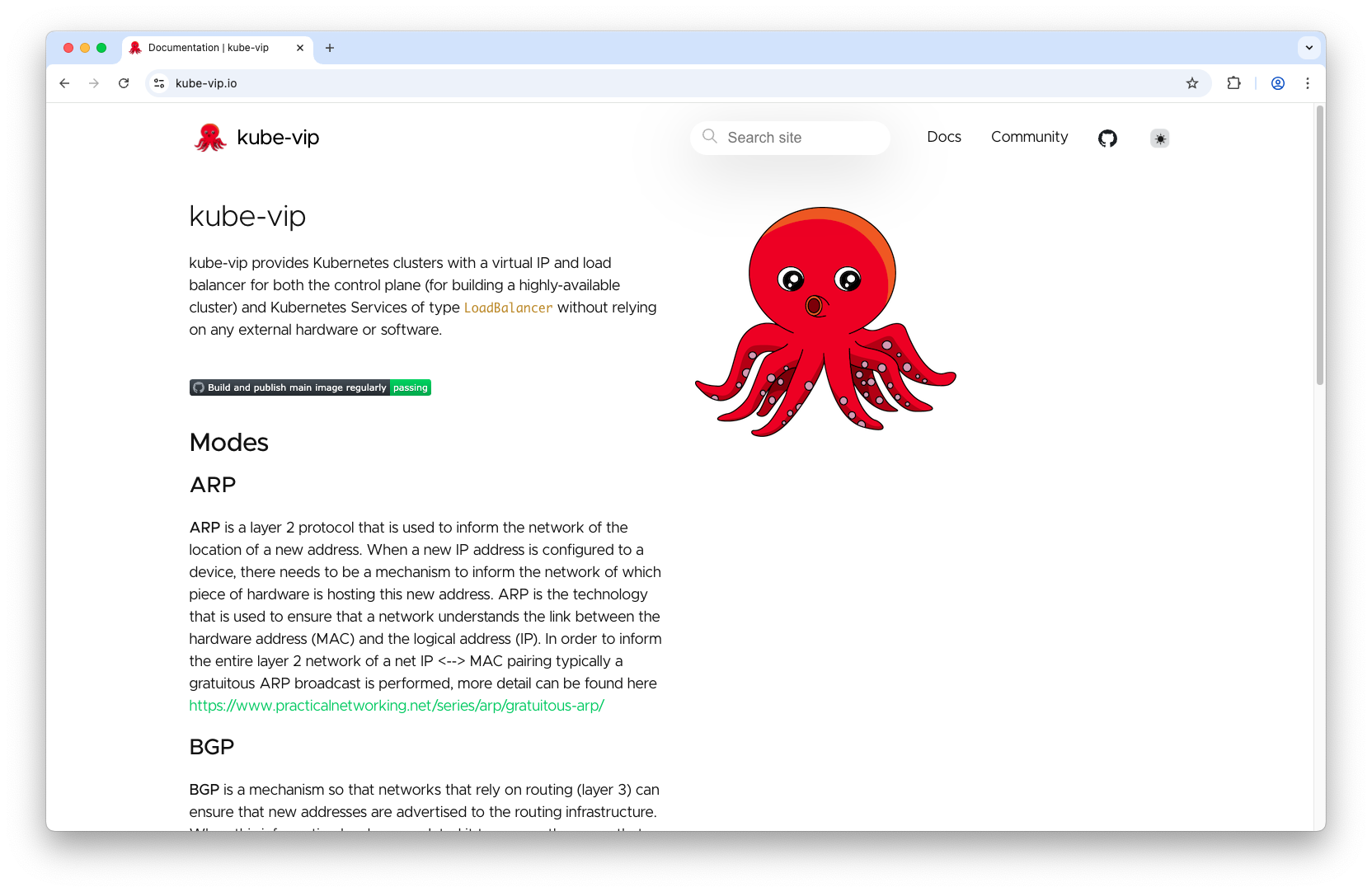Hosting Game Servers on Bare Metal Kubernetes with kube-vip
Wed 23 April 2025Hosting game servers on Kubernetes is rather straight forward if you use the offerings of the main cloud providers like AWS or Google. If you were using these cloud offerings, you might know that this can get rather expensive.
So how are you going to do that on bare metal Kubernetes? There are solutions like Agones if you want to become very serious about it and want to run some game server farm.
But what if you happen to run your own Kubernetes clusters on bare metal and just want to host a couple of game servers with low effort (like I do)? In this article, I will sketch out the solution I found for my use case.
UDP protocol
Usually dedicated game servers use UDP protocol for their client communication. Handling the network traffic for UDP protocol is a bit challenging with Kubernetes: Kubernetes Ingress only supports TCP/HTTP protocols. Therefore, leveraging an ingress controller for this task is pointless.
So how can we handle the incoming UDP traffic and forward it to the game server in Kubernetes? The First part of the
solution is a Service of type LoadBalancer. Here
we need to declare all ports the game server uses and connect them via
EndPoints to the
Deployment/Statefulset which runs the game server. Cloud provider's load balancers then connect to that Service and
configure the ingress in the status.loadbalancer field of that Service. For instance:
apiVersion: v1
kind: Service
status:
loadBalancer:
ingress:
- ip: 111.112.12.34
ipMode: VIP
ports:
- port: 28015
protocol: UDP
- port: 28016
protocol: UDP
- port: 28016
protocol: TCP
- port: 28017
protocol: UDP
- port: 28082
protocol: TCP
So an external IP address becomes assigned to that Service. The ingress traffic is routed to that service. And usually egress traffic is routed through that external IP address as well.
kube-vip
How can we achieve this on bare metal Kubernetes? This is where the kube-vip project kicks in.

With kube-vip-cloud-provider you can configure external IP addresses for your Kubernetes cluster. There are two options:
- pools of external IP addresses using a ConfigMap (load balanced)
- single static IP address by annotating a service (not load balanced)
With kube-vip you can then connect and configure these external IP addresses to a Service of type LoadBalancer. This is one of the features of kube-vip. Another feature of kube-vip is providing a VIP and doing load balancing for the Kubernetes control plane. But this is not relevant here and can be switched off. You can toggle any features using CLI flags.
kube-vip can also route the egress traffic through the external IP you configured for a service. This is what we need to use for the Service for our game server.
kube-vip installation
I choose to install kube-vip-cloud-provider and
kube-vip using their Helm charts.
This is convenient and works well. For the kube-vip values.yaml there are a couple of things to consider: we need to
configure a special image with iptables to enable the egress-functionality.
Also, we want to disable the control plane VIP functionality as we only want to use the Service feature. If we want to
use the egress feature,
we need to enable the svc_election feature. Our values.yaml should look like this eventually:
image:
repository: ghcr.io/kube-vip/kube-vip-iptables
tag: "v0.9.0"
env:
cp_enable: "false"
svc_enable: "true"
svc_election: "true"
Please note: I discovered a bug in kube-vip Helm chart. For the ClusterRole, the permission to list pods was missing which was effecting egress config. Until my fix is merged, you can patch the ClusterRole manually.
You can install the charts like so:
$ helm repo add kube-vip https://kube-vip.github.io/helm-charts
$ helm install kube-vip-cloud-provider kube-vip-cloud-provider --namespace kube-system
$ helm install kube-vip kube-vip --namespace kube-system --values values.yaml
Service configuration
After everything is up and running, you can install a Service for your game server. kube-vip supports services with mixed protocols (TCP/UDP) for ports, so we can specify all ports in one service. There are a couple of things we need to consider here additionally.
Annotations
First we need to annotate our service to enable the egress functionality with kube-vip.io/egress: "true". If we want
to expose the server via a single static IP address, we need to add this annotation
kube-vip.io/loadbalancerIPs: "111.112.12.34",
Service spec
We need to have a Service with type: LoadBalancer. If we want to have the egress functionality, we need to set
externalTrafficPolicy: Local.
Example
For instance, a Service for a Rust dedicated server would look like this:
apiVersion: v1
kind: Service
metadata:
annotations:
kube-vip.io/egress: "true"
kube-vip.io/loadbalancerIPs: "111.112.12.34"
labels:
app.kubernetes.io/instance: rust-dedicated-server
app.kubernetes.io/name: rust
name: rust-dedicated-server
spec:
type: LoadBalancer
externalTrafficPolicy: Local
ports:
- name: server-port
nodePort: 30553
port: 28015
protocol: UDP
targetPort: server-port
- name: rcon-port-udp
nodePort: 32396
port: 28016
protocol: UDP
targetPort: rcon-port-udp
- name: rcon-port-tcp
nodePort: 32396
port: 28016
protocol: TCP
targetPort: rcon-port-tcp
- name: query-port
nodePort: 30401
port: 28017
protocol: UDP
targetPort: query-port
- name: app-port
nodePort: 32164
port: 28082
protocol: TCP
targetPort: app-port
selector:
app.kubernetes.io/instance: rust-dedicated-server
app.kubernetes.io/name: rust
Check Service configuration
After installing the Service, it takes a while until kube-vip assigns the external ingress IP address and the egress configuration. Check the logs of kube-vip-cloud-provider pods for the handling of external ingress IP address. Or the logs of kube-vip pod for egress handling. You should see ingress IP assigned (status) and egress configuration (annotations) in the Service object:
$ kubectl -n yournamespace get svc yourservice -o yaml